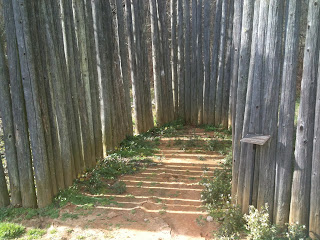Jan Hus began the movement in the late 1300's in Moravia, a Czech province, to protest some of the Roman Catholic tenets, hence it being one of the earliest "Protestant" faiths. Hus was martyred by the Roman Catholics in 1415. All of this was nearly 100 years before Martin Luther, who some consider the "father" of the Protestant reformation.
Fast forward to 1753, when fifteen men from the Moravian Church came to North Carolina and established Bethabara. It was never meant to be a permanent settlement - just a stopping place to scout the area and decide the best location for what was to become the permanent location, Salem (now known as Old Salem.) The men came to this hundred-thousand acre tract known as Wacovia because the church back in Moravia had purchased it. It was 1771 before (Old) Salem was completed and folks began to relocate there. Bethabara became just a farm to provide produce and medicinal herbs for the settlers.
The original 1753 village was to the northeast of the garden. Moravian's actually planned the location of structures in their towns before building them, so there are actual maps of where each structure was built and what it's use would have been.
Later, in 1756, a five-sided palisade fort was constructed to the southwest of the garden for protection against attack because of the ongoing French and Indian War (1689? or 1754? - 1763):
complete with bastions:
At first I wondered if maybe these were nifty little niches to park their wagons in. Then I thought, that's a LOT of work for wagon garages... Finally I saw a plaque that 'splained it to me: They are built out from the corners of the fort so guards could look down two sides of the outside walls for attackers. Pretty smart, huh?
Bastions.
This (reconstructed) palisade fort is the only one in the Southeast from the French and Indian War era still located on its original site.
Inside the palisade are rock cellars excavated in the 1960's. The buildings over the cellars were much larger, but these are all that remain. After moving to Salem, these foundations were filled in with dirt to provide a larger area for farming. By 1773 the Bethabara community contained over 75 major structures.
 |
| Doctor's Laboratory 1759 |
 | ||
| Apothecary Shop Foundation 1763 |
 |
| Pottery Dependency 1756 |



No comments:
Post a Comment